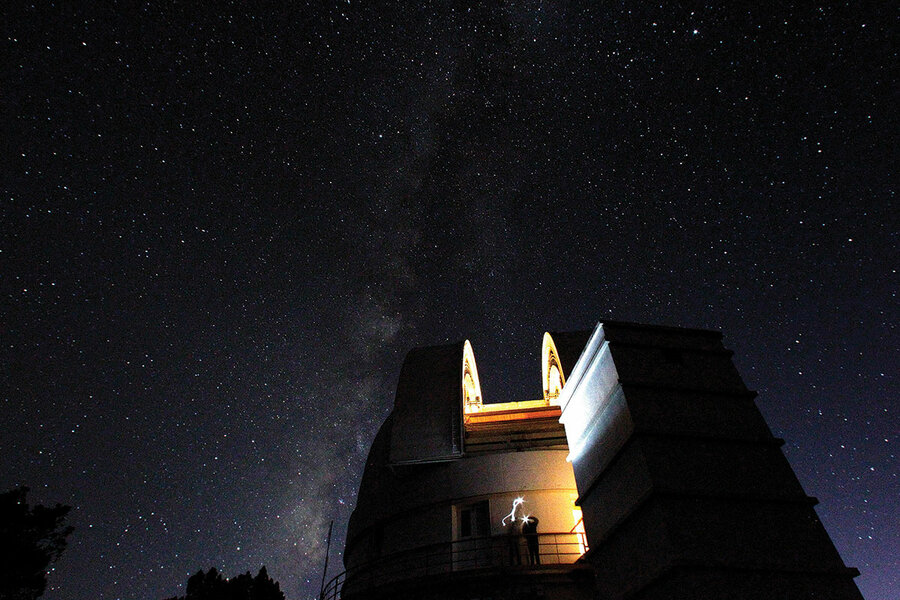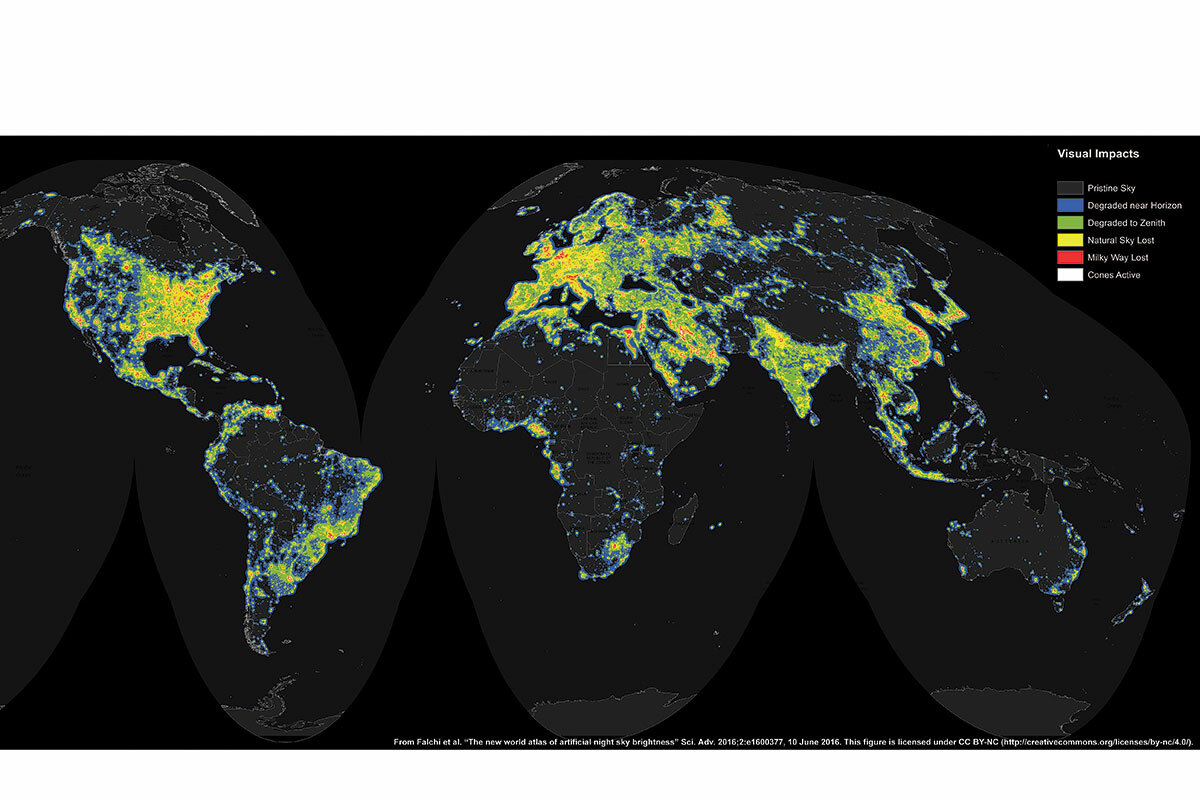In Texas Hill Country, darkness enlightens and inspires
Loading...
| Pflugerville, Texas
The city of Blanco sits on the edge of darkness, and it’s trying to stay there.
Nestled in the rural Hill Country of Central Texas, the 1,700-person town is confronting a challenge both new and ancient: light pollution. As the world urbanizes, dark skies are becoming increasingly vulnerable – and treasured. One-third of humanity can’t see the Milky Way, a 2016 study found, including nearly 80% of North Americans.
Why We Wrote This
A story focused onLight may be a symbol of progress, but these communities treasure the humbling wonders of the dark.
Grassroots activism and technological innovation have resulted in vast swaths of Central and West Texas protecting views of the stars as they would air and water – and in a way that shouldn’t conflict with development, advocates say.
The fix can be as simple as changing a lightbulb, and the benefits could be immense: from clear views of distant planets and galaxies, to an escape from frenetic modern life, to inspiring future generations through the wonders of the cosmos.
“Of all of the forms of pollution that mankind has foisted on this Earth, light pollution is the easiest and the cheapest to fix,” says Wayne Gosnell, an advocate of dark skies, “and we can do it in our own lifetime.”
The city of Blanco sits on the edge of darkness, and it’s trying to stay there.
Nestled in the rural Hill Country of Central Texas, the 1,700-person town is growing – but locals are wary of losing the longtime neighbor they all share: the neighbor that lives overhead.
“For our citizens it’s really important to keep our small-town charm,” says Rachel Lumpee, the city’s mayor. “And part of that charm is being able to see the Milky Way.”
Why We Wrote This
A story focused onLight may be a symbol of progress, but these communities treasure the humbling wonders of the dark.
Blanco is confronting a challenge both new and ancient. Darkness and light have been antagonists for most of human history, and light pollution is a relatively new, widespread, and underappreciated environmental hazard. One-third of humanity can’t see the Milky Way, a 2016 study found, including nearly 80% of North Americans. By 2050 over two-thirds of the world’s population will be living in urban areas, the United Nations projects. Light pollution has been found to have a range of negative effects on humans, wildlife, and even plant life.
As the world urbanizes, dark skies are becoming increasingly vulnerable – and treasured. And for years, the Hill Country region has been leading the way in preserving and expanding them. Grassroots activism and technological innovation have resulted in vast swaths of Central and West Texas protecting views of the stars as they would air and water – and in a way that shouldn’t conflict with development, advocates say.
“Out of all the different kinds of pollution we have in this world, [light pollution] is the quickest one to fix,” says Dawn Davies, night sky program manager at the Hill Country Alliance, a regional conservation nonprofit.
The fix can be as simple as changing a lightbulb, and the benefits could be immense: from clear views of distant planets and galaxies, to an escape from frenetic modern life, to inspiring future generations through the wonders of the cosmos.
The night sky “inspires people; it touches them on a very deep level,” adds Ms. Davies. And “there’s so many people that ... don’t know that they’re missing, and don’t know what they’re lacking.”
A solvable problem
When he retired from the U.S. Army, Wayne Gosnell and his wife could have lived anywhere. It was the night sky that drew them to Blanco. It reminds Mr. Gosnell of his place in the universe, he says, and of his childhood in West Texas.
“It would always knock my socks off when I went out,” he adds.
He started protecting dark skies in Blanco 15 years ago, by setting up light meters around town. It’s becoming increasingly important work, as the Hill Country – flanked to the east and south by the cities of Austin and San Antonio – has become one of the fastest-growing areas of the country.
With development comes light pollution, a steady glow that disrupts the natural rhythms of plants and animals – including humans. It contributes to the deaths of millions of migratory birds every year, studies have found, and it’s a fast-growing threat to firefly populations around the world.
The Texas Hill Country is leading the way with one of the most protected night skies in the world. The region is home to five of the world’s 38 “Dark Sky Communities” recognized by the International Dark-Sky Association. In April, following a yearslong effort – including a 295-page application – spearheaded by Mr. Gosnell, Blanco became the fifth.
“Of all of the forms of pollution that mankind has foisted on this Earth, light pollution is the easiest and the cheapest to fix,” says Mr. Gosnell, “and we can do it in our own lifetime.”
Can darkness be a “win-win”?
Earlier this year, as Blanco was receiving its dark sky recognition, far West Texas was celebrating as well. The Greater Big Bend International Dark Sky Reserve – certified this spring – spans over 15,000 square miles of southwest Texas and northeast Mexico.
“It’s the largest area in the world where the night sky is protected,” says Stephen Hummel, with the University of Texas at Austin’s McDonald Observatory. “I’m quite proud of it.”
Mr. Hummel coordinates the Dark Skies Initiative at the observatory, which basically means his job is to ensure the skies around the observatory stay dark. In West Texas, that work involves a lot of cooperation with the oil and gas industry.
He has worked with it to incorporate intentional lighting designs. Simple changes such as focusing lights downward, installing timers, and using less intense bulbs can reduce spillover – and lower energy bills. The energy company Apache signed on as an official supporter of the initiative.
“A lot of people assume we’re just asking people to turn their lights off and live in darkness, and that’s just not the truth,” says Mr. Hummel.
“To an oil and gas company, it does make sense for them to adopt a night sky-friendly lighting strategy,” he adds. “It saves them money, it’s better for workplace safety, [and] it’s better for the health of their workers.”
In many ways, protecting night skies is that simple – like directing light intentionally, opting for softer orange light instead of harsh white light, and using light only when you need it – and it’s giving dark sky protectors around Texas hope that light pollution can be significantly reduced without restricting development. The Big Bend area illustrates that “win-win” scenario, Mr. Hummel says, by having the world’s largest dark sky reserve near one of its largest energy-producing areas.
In Blanco, Mayor Lumpee is hoping for the same thing. Blanco is still a small town, but the Hill Country is booming. “I don’t think there’s any avoiding new people coming in, or new businesses coming in,” she says. “The important thing is to do it healthily.”
If places like Blanco can grow while preserving their dark skies, it will open up to future generations the wonders of the heavens. “Imagine living somewhere where, during daytime, the vast majority of what you could see is obscured in fog,” says Ms. Davies at the Hill Country Alliance.
“If you can only see two or three bright stars, you’re missing out on seeing where we are in the cosmos.”









